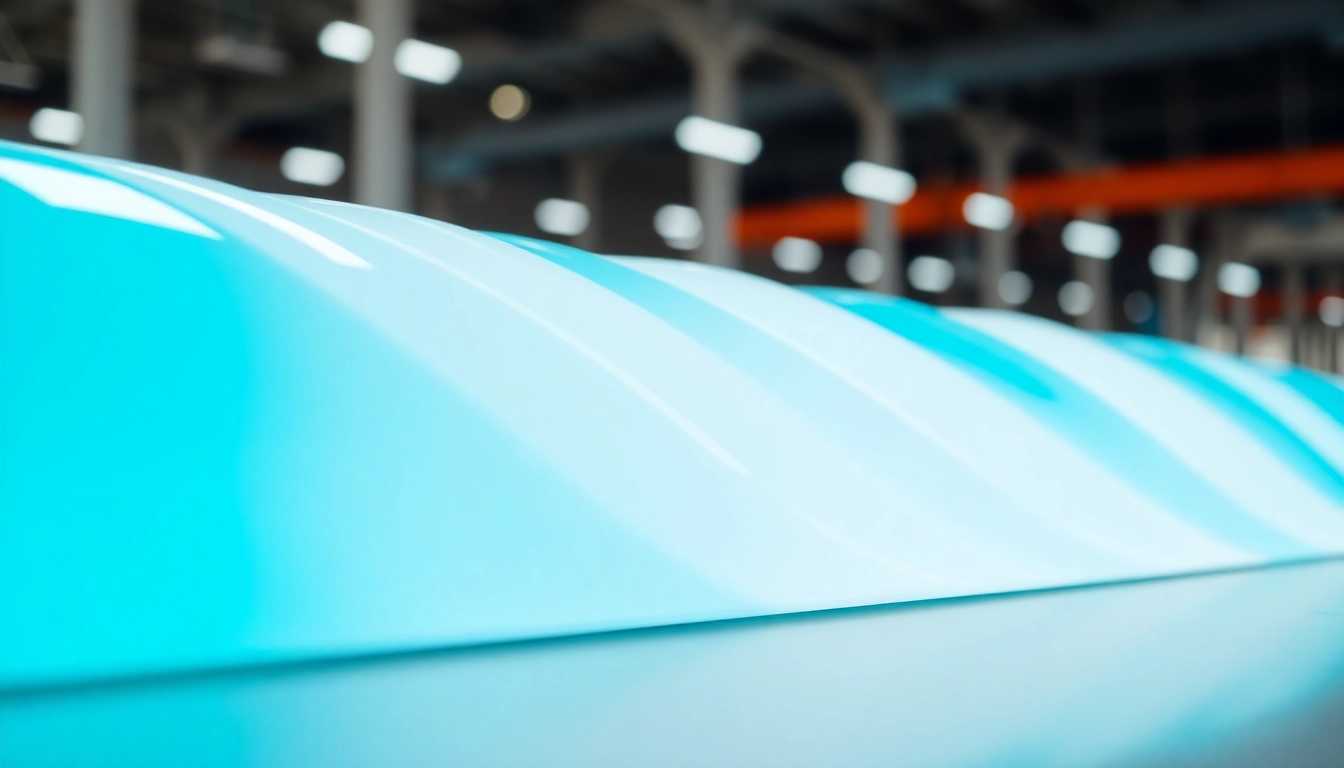Introduction to Blow Molding Machines
In today’s manufacturing landscape, the demand for efficient and versatile production methods has never been higher. One of the most innovative techniques that have emerged is blow molding, a manufacturing process essential for creating a wide array of plastic products. A Blow Molding Machine is a key player in this field, utilized extensively across various industries to produce hollow plastic items at scale. This article delves into the intricate workings of blow molding machines, their applications, selection criteria, best practices for operation, and innovations shaping the future of this crucial manufacturing process.
What is a Blow Molding Machine?
A blow molding machine is a specialized piece of equipment used to manufacture hollow plastic products through a method that involves inflating heated plastic into a mold. The technology primarily works through one of three processes: extrusion blow molding, injection blow molding, or injection stretch blow molding.
The basic operation starts with plastic being heated until it becomes pliable. In the case of extrusion blow molding, a parison—a hollow tube of molten plastic—is formed and then clamped into a mold, where it is inflated with air to take the shape of the mold. Conversely, in injection blow molding, the molten plastic is injected into a mold and then blown into its final form, allowing for greater precision and surface finish. These processes not only ensure the efficiency of production but also maintain consistent quality across large batches.
Types of Blow Molding Processes
Understanding the types of blow molding processes is crucial in choosing the right machine for specific manufacturing needs. The three primary types include:
- Extrusion Blow Molding (EBM): This is the most commonly used method for producing large quantities of hollow items like bottles and containers. The process involves extruding molten plastic into a parison, which is then inflated to fill the mold.
- Injection Blow Molding (IBM): This method combines injection molding and blow molding for producing precise and complex parts. Here, the plastic is injected into a mold to form a preform, which is then transferred to a blow mold to achieve the final shape.
- Injection Stretch Blow Molding (ISBM): This technology is similar to IBM but includes an additional stretching process for better material orientation, resulting in stronger and lighter products, which is particularly beneficial in the packaging of beverages.
Applications and Industries Using Blow Molding
Blow molding machines find their utility across a multitude of industries, shaping everything from everyday household items to specialized industrial components. Major applications include:
- Food and Beverage Packaging: The production of lightweight, durable bottles for beverages is predominantly done via blow molding, ensuring ease of transport and safety.
- Automotive Components: Components like fuel tanks, air ducts, and other hollow parts are often produced using blow molding for their lightweight yet robust characteristics.
- Consumer Products: Items such as toys, cosmetic containers, and various household goods are regularly manufactured using this method due to its efficiency and cost-effectiveness.
- Medical Supplies: The sterile production of containers and other medical devices also uses blow molding to meet stringent industry standards.
Choosing the Right Blow Molding Machine
Criteria for Selection
Selecting the appropriate blow molding machine requires careful consideration of several key factors. The criteria typically include:
- Production Volume: The anticipated output will significantly influence the choice between semi-automatic or fully automatic machines.
- Complexity of the Product: The design and specifications of the required products will dictate the type of blow molding technology to be employed.
- Material Compatibility: Different machines have varying capabilities with respect to the types of plastics they can process; therefore, it is essential to ensure that the selected machine can handle the required materials.
- Budget Constraints: The financial aspect cannot be overlooked; initial capital, operational costs, maintenance, and potential return on investment are integral to the decision-making process.
Cost Considerations
The cost of blow molding machines can vary widely depending on the type of machine, its capabilities, and the configuration required. A basic extrusion blow mold might start around $3,000, whereas multi-cavity molds can exceed $25,000. Factors influencing these costs include:
- The complexity of the mold design
- The required production capacity
- The inclusion of advanced automation features
- Post-production services and support from suppliers
Supplier Evaluation
Choosing a trustworthy supplier is as essential as selecting the right machine. Potential suppliers should be evaluated on their experience, support capabilities, and reputation in the industry. Factors to consider include:
- After-Sales Support: Review the warranty and maintenance offerings to ensure long-term operational efficiency.
- Customer References: Speak to existing customers about their satisfaction with both the machine and the service provided.
- Technological Advancements: Prefer suppliers who stay current with the latest developments in blow molding technology.
Best Practices for Operating Blow Molding Machines
Setup and Configuration
Efficient operation of a blow molding machine starts with proper setup and configuration. Important steps include:
- Mold Preparation: Ensure that the mold is clean, properly aligned, and free from defects.
- Material Handling: Confirm that the materials are stored correctly and prepared following manufacturer specifications to reduce processing time.
- Calibrating Machine Parameters: Adjust parameters such as temperature, pressure, and timing based on the material properties and product specifications.
Maintenance Tips
Regular maintenance of blow molding machines is crucial to avoid downtime and ensure consistent product quality. Recommended maintenance practices include:
- Daily Cleaning: Remove any residue from the machine, particularly around the molds to prevent contamination.
- Periodic Inspections: Conduct checks on belts, screws, and heaters to identify potential issues before they escalate.
- Lubrication: Regularly lubricate moving parts to minimize wear and tear.
Common Issues and Solutions
Operators should be prepared to encounter various challenges when running a blow molding machine. Some common issues include:
- Inconsistent Production Quality: This can often be resolved by adjusting the machine settings or recalibrating the molds.
- Material Waste: Minimizing waste can be achieved by ensuring optimal parison sizes and reducing cycle times.
- Frequent Downtime: Implementing preventive maintenance schedules can help reduce unexpected machine failures.
Innovations in Blow Molding Technology
Recent Advancements
The blow molding industry has witnessed significant technological advancements aimed at improving efficiency, reducing waste, and enhancing product quality. Notable innovations include:
- Smart Technology: The integration of IoT devices in blow molding machines allows for remote monitoring, predictive maintenance, and real-time data analytics.
- Energy Efficiency: New machines are being designed with energy-saving features that minimize power consumption while maximizing output.
- Advanced Materials: The use of bio-based and recycled plastics is becoming more prevalent, supported by machines that can process these materials without compromising quality.
Eco-friendly Blow Molding Solutions
As industries increasingly adopt sustainable practices, eco-friendly blow molding solutions are gaining traction. This includes:
- The use of biodegradable materials that can efficiently decompose after usage.
- Processes that minimize energy usage and reduce overall carbon footprints during production.
- Initiatives promoting recycling and the use of post-consumer resin in the manufacturing process.
Future Trends in Blow Molding
Looking ahead, the blow molding industry is set to evolve in several ways, including:
- Automation: The rise of automated solutions will streamline operations and improve precision.
- Customization: Increased demand for tailored products will lead to the development of flexible manufacturing systems that can adapt to different requirements.
- Sustainability Focus: Continued emphasis on reducing environmental impact will drive innovation towards greener technologies and materials.
Case Studies: Successful Implementations
Industry Examples
Numerous industries have successfully implemented blow molding solutions to enhance their productivity and product offerings. Here are some illustrative examples:
- Food and Beverage Sector: A leading beverage manufacturer utilized advanced blow molding technology to significantly improve production efficiency, resulting in a 30% reduction in costs.
- Automotive Industry: An automaker integrated blow molding for fuel tank production, which not only reduced material waste but also improved safety and durability of the components.
Performance Metrics
Organizations deploying blow molding machines have reported measurable performance improvements, such as:
- Increased Production Rates: Many organizations have noted up to a 50% increase in output granted by modernized blow molding processes.
- Reduced Labor Costs: Automation and efficiency have allowed for labor reductions of over 20% in some cases.
- Enhanced Quality Control: Advanced monitoring systems lead to less rework and scrap, improving overall product quality and customer satisfaction.
Customer Testimonials
Feedback from customers utilizing blow molding machines underscores their value:
“The transition to a fully automated blow molding line has changed our operations for the better. We’ve seen unparalleled efficiency and product quality.” – Production Manager, Leading Beverage Company
“The ability to customize our products with minimal lead time has given us a significant advantage in the market.” – R&D Supervisor, Automotive Manufacturer



